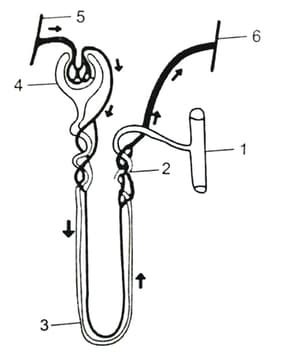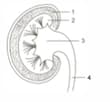MEDIUM
10th ICSE
IMPORTANT
Earn 100
The given diagram represents a nephron and its blood supply. Study the diagram and answer the following questions:

(i) Label parts 1, 2, 3 and 4.
(ii) State the reason for the high hydrostatic pressure in the glomerulus.
(iii) Name the blood vessel which contains the least amount of urea in this diagram.
(iv) Name the two main stages of urine formation.
(v) Name the part of the nephron which lies in the renal medulla.

Important Questions on Human Excretory System
EASY
10th ICSE
IMPORTANT
Give the biological/technical terms for:
The hormone increasing reabsorption of water by kidney tubules. (Oxytocin/Antidiuretic hormone)
HARD
10th ICSE
IMPORTANT
The diagram given below shows a section of a human kidney. Study the diagram carefully and answer the questions that follow:

(i) Label the parts numbered 1 to 4.
(ii) Why does the part '2' have striped appearance?
(iii) What is the fluid that passes down part '4'? Name the main nitrogenous waste present in it.
(iv) Mention the structural and functional units of kidneys.
(v) Name the two major steps in the formation of fluid urine.
MEDIUM
10th ICSE
IMPORTANT
Draw neat and labelled diagrams of the malpighian Capsule.
EASY
10th ICSE
IMPORTANT
Explain the term:
Selective reabsorption
EASY
10th ICSE
IMPORTANT
State the exact location of the:
Proximal convoluted tubule.
EASY
10th ICSE
IMPORTANT
Give the Biological / technical term for the:
Pigment providing colour to urine
EASY
10th ICSE
IMPORTANT
Give the biological/technical term for the:
The removal of nitrogenous wastes from the body.
EASY
10th ICSE
IMPORTANT
Name the organ which produces urea.
